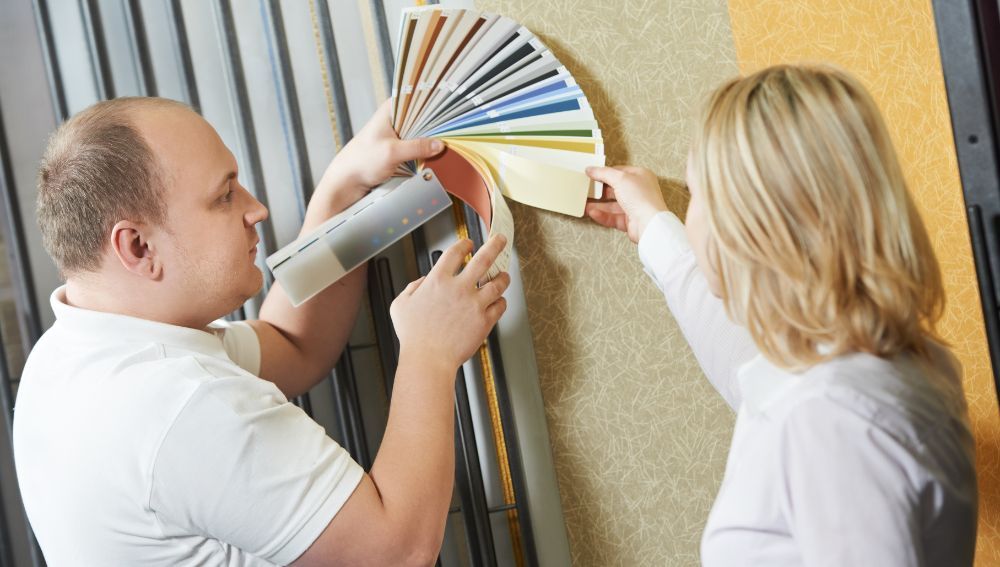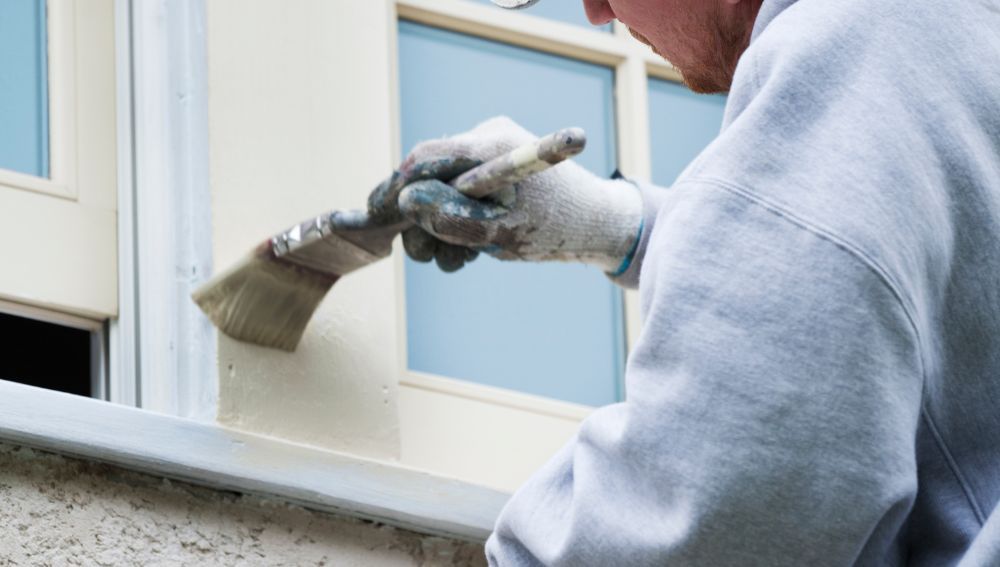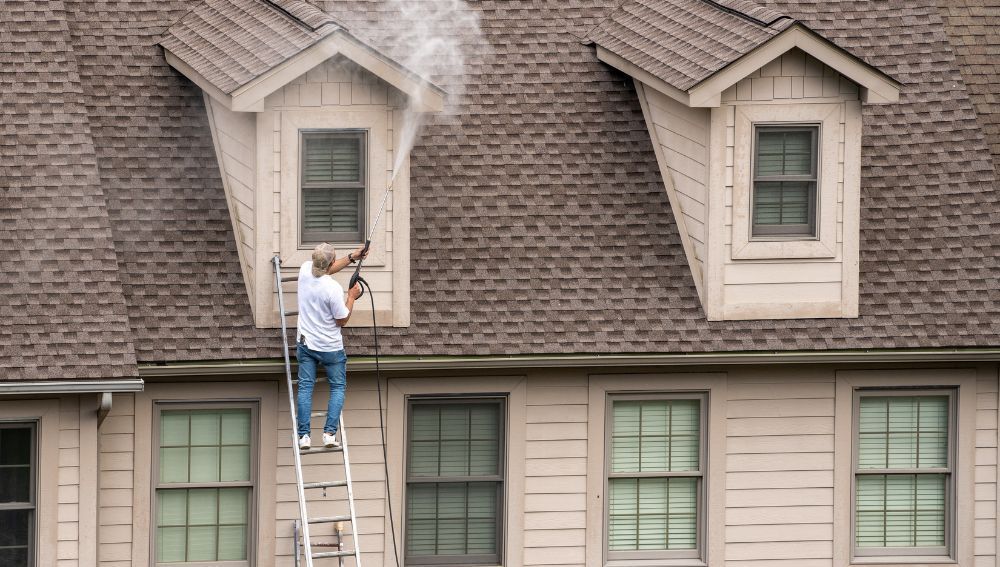Exterior Painting Services
Interior Services
Exterior Services
Floor Services
Drywall Services
Removal Services
1st Painting Contractors did a very careful job for the interior of my townhouse. The painters left an immaculate new appearance in my home. I am refreshed by the new look on all the walls. I would recommend 1st Painting Contractors for anyone looking for professional painters. I will definitely use them again.
How to Paint a House Exterior and How Much Does It Cost to Paint the Exterior
Your home's exterior is its first impression, silently welcoming guests and showcasing your personal style. Yet, it also faces the unrelenting forces of nature - sun, rain, wind, and more - that’s where exterior painting comes here.
A fresh coat of paint breathes new life into your home's exterior, boosting its visual appeal and adding a touch of personality. Imagine the transformation - vibrant colors, crisp lines, and a renewed sense of charm!
Quality exterior paint acts as a shield, guarding your home against weather elements that can cause damage over time. It prevents moisture infiltration, protects against UV rays, and even helps regulate indoor temperatures.
The exterior painting process involves several key steps:
- Preparation - Including the removal of old paint and choosing the right exterior paint color. This crucial stage involves cleaning, scraping, and repairing any imperfections on the surface. A clean and sound foundation ensures the paint adheres properly and lasts longer.
- Choosing the right paint - Selecting the right type of paint based on your climate, material, and desired finish is essential for optimal results. From durable latex to weather-resistant acrylics, there's a perfect option for your needs.
- Painting with precision - Careful application using a brush or roller, or sprayer ensures a smooth, even finish. Techniques like cutting in and backrolling guarantee a professional-looking outcome.
- Final touches - Once the paint dries, addressing any missed spots and touching up hardware completes the transformation, marking the completion of your home improvement effort with a fresh layer of new paint.
Planning and Preparing to Paint the Exterior of Your House
Before you grab your brush and paint your home's exterior, thorough planning ensures a smooth, successful, and budget-friendly exterior painting project.
When it comes to evaluating the scope of your exterior painting, size matters. Measure the total square footage of your home's exterior surfaces (walls, trim, etc.). Consider complexities like multiple stories, intricate details, or unique architectural features that might require extra time and effort.
Identify the different types of surfaces you'll be painting (e.g., wood, vinyl, stucco). Each material has specific requirements for preparation, paint type, and application techniques.
Choosing the right time is also vital. Avoid extreme temperatures below 50°F or above 85°F, as paint won't cure properly. Settle for mild, sunny days with moderate humidity (40-70%).
Avoid painting on rainy or excessively windy days, as moisture can disrupt the painting process and affect the final finish.
For budgeting, research paint prices based on quality, coverage, and the amount needed for your project. Consider investing in higher-quality paint for better durability.
Assess whether you already own essential tools like brushes, rollers, drop cloths, and safety equipment. Factor in rental or purchase costs if needed.
Evaluate your DIY skills and comfort level. For large, complex projects, consider consulting a professional painter for estimates and potential cost savings through their expertise and efficiency.

Selecting Paint and Tools to Paint a House Exterior
With your project planned, it's time to choose the tools and paint that will bring your vision to life, ensuring to account for the average cost per square foot.
You can use different types of paint. Popular options include:
- Acrylic paints - a popular choice for both their durability and ease of application on different types of siding. Popular choice for their durability, ease of use, and fast drying time. Ideal for most exterior surfaces like wood, vinyl, and siding.
- Latex paints - Another popular option, offering good durability and affordability. Water-based and easy to clean up, but may require more coats than acrylics. This factor can influence the total cost of painting the exterior of your entire house.
- Oil-based paints - Offer superior durability and a smooth finish, but require longer drying times, stronger solvents for cleanup, and are more prone to fumes. Best suited for specific applications like bare wood or metal exterior doors.
Note: When choosing paint, consider factors like surface type, climate, desired finish, and durability requirements. Consult paint store professionals for guidance based on your specific needs.
For color, consider your home's architectural style. Traditional styles work well with classic colors like white, cream, or muted earth tones, complementing the aesthetic of the home exterior. Modern styles can handle bolder palettes, while contemporary homes might favor monochromatic schemes.
Consider the colors of neighboring houses, landscaping, and overall community aesthetic to create a cohesive look.
Purchase small sample pots and paint test patches on different areas of your house to see how the colors interact with natural light and shadows.
Regarding tools, you’ll need:
- Brushes - Different sizes and types (nylon/bristle) for detailed work, trim, and larger areas.
- Rollers - Choose nap size based on surface texture (short for smooth, long for rough).
- Sprayer (optional) - Offers faster coverage for large areas, but requires practice and proper safety gear.
- Ladders and scaffolding - integral for reaching all areas when planning to paint the exterior of a home. Ensure safe access to all areas.
- Drop cloths and masking tape - essential for protecting surfaces and achieving clean lines, especially when applying new paint. Protect surrounding areas from paint splatters.
- Safety gear - Goggles, gloves, respirator for proper protection.
Preparation of the Paint Exterior Area
The crucial preparation stage ensures the paint adheres properly and your newly painted masterpiece weathers the elements beautifully. Thorough cleaning, repairing imperfections, and applying primer are essential investments in the longevity and beauty of your finished paint job. Don't skip these crucial steps!
Dirt, grime, and mildew act as barriers to paint adhesion, leading to peeling and flaking. Invest in a power washer (or rent one) for a thorough cleaning. Use appropriate pressure settings based on your home's siding material.
Be cautious around delicate areas like windows, doors, and landscaping. Cover them with plastic sheeting to prevent damage.
Inspect your home's exterior for cracks, holes, loose paint, and other imperfections. Use appropriate exterior caulk or patching compounds to fill and repair these areas. Allow repairs to dry completely before proceeding.
Sanding smooths out rough surfaces like uneven wood or patched areas. Use the appropriate grit sandpaper (120-150 for most surfaces) and sand with light, even strokes. Remove sanding dust with a broom or vacuum cleaner.
Primer acts as a bridge between the surface and the paint, promoting better adhesion and creating a uniform base for even color application.
Use a high-quality exterior primer specifically formulated for your home's siding material (wood, vinyl, stucco, etc.). Apply a thin, even and fresh coat of exterior painting following the manufacturer's instructions. Allow the primer to dry completely before painting the exterior of your home.

Painting Techniques for Exterior Surfaces
Brushes are ideal for detailed work, trim, corners, and tight spaces. Use short, smooth strokes in the direction of the grain or texture. Load the brush with a moderate amount of paint to avoid drips.
Rollers are perfect for large, flat areas like exterior walls and siding. Choose the right nap size based on surface texture (short for smooth, long for rough). Apply thin, even coats with light pressure, overlapping each stroke slightly.
Sprayers offer speed and efficiency for large, flat surfaces, reducing the average cost per square foot of painting. However, proper technique and safety gear are crucial. Practice on scrap material before tackling your house.
Maintain a consistent distance and spray in smooth, overlapping strokes using a paint sprayer for uniform coverage. Use drop cloths and masking tape generously to protect surrounding areas. Wear a respirator and goggles for safety.
You need to be savvy when it comes to painting different surfaces of the exterior of a house.
- Wood - Choose high-quality exterior paint suited for wood. Use a brush for trim and detailed areas, and a roller for flat surfaces, considering the exterior paint color for a unified appearance. Pay extra attention to end grains and apply additional coats if needed.
- Stucco - Choose a paint specifically formulated for stucco's porous nature. Apply a thin first coat with a roller, followed by a thicker second coat for even coverage. Be mindful of drips and splatters on textured surfaces.
- Metal - Use a rust-inhibiting primer and paint specifically designed for metal when planning to repaint the exterior of a house. Sand lightly before painting and avoid applying paint in direct sunlight, as it can dry too quickly.
Note: Practice makes perfect! Experiment on inconspicuous areas first and adjust your technique as needed. Don't be afraid to seek advice from professionals for specific materials or challenging areas.
Painting Specific Exterior Areas Including Siding
There are specific areas that require focused attention for a polished, professional finish.
- Edges and corners - Use angled brushes for precise application. Start with the top edge, then move to sides and bottom. Overlap slightly onto the main surface for seamless blending.
- Window frames - Remove sashes if possible and mask glass and surrounding areas carefully. Use small brushes for detailed work and a roller for flat surfaces.
- Decorative details - Employ small brushes and steady hands for intricate designs. Consider using painter's tape for crisp lines.
- Wood siding - Ensure proper ventilation and avoid painting in direct sunlight. Use high-quality exterior paint and apply thin, even coats, following the grain. This technique is key to a professional-looking home exterior. Pay extra attention to areas prone to moisture.
- Vinyl siding - Choose paint specifically formulated for vinyl. Clean thoroughly and avoid using oil-based paints. Apply light coats with a roller or brush, working in small sections.
- Brick siding - when planning to paint, consider the type of siding as it influences the choice of new paint and application methods. Choose breathable masonry paint. Brush or roll carefully, avoiding mortar joints. Consider a second coat for even coverage, but avoid oversaturation. This is especially important in an exterior paint job to ensure longevity.
When it comes to doors and windows, remove hardware and mask surrounding areas thoroughly.
For doors, start with the trim, panels, and stiles, then move to the main surface. Use a brush for detailed work and a roller for flat areas. Allow each coat to dry completely before applying the next.
For windows, remove sashes if possible and paint frames first. Use painter's tape to protect glass and weather stripping. Be mindful of drips and splatters.
Detail Work and Finishing Touches on House Paint
No matter how meticulous you are, minor drips, missed spots, or blemishes might appear, you shouldn’t downplay the power of touch-ups.
Use small brushes for precise corrections. Match the paint color exactly and apply light, feathery strokes to blend seamlessly. Address blemishes like nail holes or paint chips and dust with patching compounds and touch-up paint for a flawless look.
To ensure your beautiful paint job withstands the elements and retains its vibrancy, consider applying a sealer or topcoat:
- Sealants - Ideal for porous surfaces like brick, stucco, or concrete. They enhance water resistance and prevent paint deterioration.
- Topcoats - Available in various finishes (gloss, satin, matte). They add an extra layer of protection against UV rays, dust, and dirt, and make cleaning easier.
Here’s how to maintain your freshly painted exterior:
- Regular cleaning - Wash your house periodically with a mild detergent solution to remove dirt and grime.
- Touch-up promptly - Address any chips, scratches, or peeling paint immediately to prevent further damage, especially if dealing with lead paint.
- Inspect annually - Check for signs of wear and tear, especially around windows, doors, and trim, as part of your evaluation before starting an exterior paint job.

Clean-up and Maintenance of Exterior House Painting
With your exterior painting project complete, it's time to ensure the tools you use are ready for your next project, and your newly painted exterior continues to shine for years to come.
- Brushes and rollers - Immediately remove excess paint by wiping with a rag soaked in paint thinner or mineral spirits (depending on paint type). Wash thoroughly with warm soapy water, rinse well, and reshape bristles before hanging to dry completely.
- Sprayer - Follow the manufacturer's instructions for cleaning the sprayer, paying close attention to nozzles and filters. Use appropriate solvents and cleaners to ensure proper functionality and prevent clogs.
For maintenance, do the following:
- Regular cleaning - Wash your exterior surfaces periodically with a mild detergent solution. Avoid harsh chemicals or abrasive cleaners that can damage the paint.
- Touch-up promptly - Don't wait for major problems! Address any chips, scratches, or peeling paint as soon as possible to prevent further damage and costly repairs.
- Inspect annually - Schedule a yearly inspection to identify any areas requiring touch-up, potential moisture issues, or signs of wear and tear, especially around windows, doors, trim, and to assess the condition of old paint.
- Consider professional maintenance - Every few years, consider hiring professional cleaners or painters to perform a deeper clean and address any minor issues before they become bigger problems.
Advanced Techniques and Considerations
You can achieve depth and visual interest by applying multiple paint colors in thin layers, blending and manipulating them for unique effects like glazing or ombre.
Introduce texture to your paint job using tools like sponges, rollers with textured sleeves, or even crumpled plastic wrap to create a rustic, aged, or weathered look.
I’d recommend going for green choices, eco-friendly painting solutions, and learning how to paint to make informed decisions. Use paints with low or zero volatile organic compounds (VOCs) to minimize harmful emissions and protect your health and the environment.
Consider paints made from plant-based ingredients like milk, clay, or lime for an eco-conscious approach with unique aesthetics.
For large, intricate projects, challenging materials, or tight deadlines, consult experienced professional painters. They can offer expertise, and efficiency, and ensure a high-quality outcome.
If you're unsure about your abilities, lack necessary equipment, or face safety concerns, hiring professionals can provide peace of mind and ensure a safe and successful project.
Here are some key considerations when working with a professional painting crew, including understanding the average cost and what to expect from a painting contractor.
- Get multiple quotes and compare credentials, experience, and insurance coverage. This way, you'll have a rough idea of the cost of the project.
- Communicate your expectations and desired outcome.
- Review contracts carefully and understand payment terms.
- Don't hesitate to ask questions and clarify any doubts throughout the process.
Conclusion
From adequate planning and preparation to mastering painting techniques and finishing touches, you can transform your home's exterior by following everything I’ve laid out in this comprehensive guide.
In summary, here’s what you need to do;
- Thorough planning - Assess the scope, choose the right time, and budget accurately.
- Preparation - Clean, repair, and prime surfaces for optimal paint adhesion.
- Selecting the right tools and paint - Choose quality tools based on your project and paint suited to your surface material and climate.
- Mastering techniques - Practice brush, roller, and (if applicable) sprayer techniques for smooth, even application when undertaking a repaint project for the exterior of a house.
- Addressing specific areas - Pay special attention to trim, details, siding, doors, and windows, using appropriate techniques for each.
- Touch-ups and finishing touches - ensure to address any old paint and plan for new paint as needed. Address imperfections, consider sealants or topcoats, and clean your tools properly, especially when working with potentially hazardous materials like lead paint.
- Regular maintenance - Wash regularly, touch-up promptly, and inspect annually for lasting beauty.
More than just aesthetics, a well-executed exterior painting project offers significant benefits:
- Enhanced curb appeal of your home - Increase your home's value and visual impact with a fresh, vibrant exterior.
- Protection against elements - Quality paint acts as a shield, safeguarding your home from weather damage, moisture infiltration, and UV rays.
- Energy efficiency - Lighter colors can reflect sunlight, potentially reducing cooling costs in hot climates and contributing to the home improvement by enhancing energy efficiency.
- Personalization and pride - Express your unique style and enjoy the satisfaction of creating a beautiful, personalized space.
Don't Miss the Chance
If you want to boost the value of your property, let us help you. We offer affordable outdoor painting services that are certain to exceed your expectations. Contact us today and get a free estimate!

